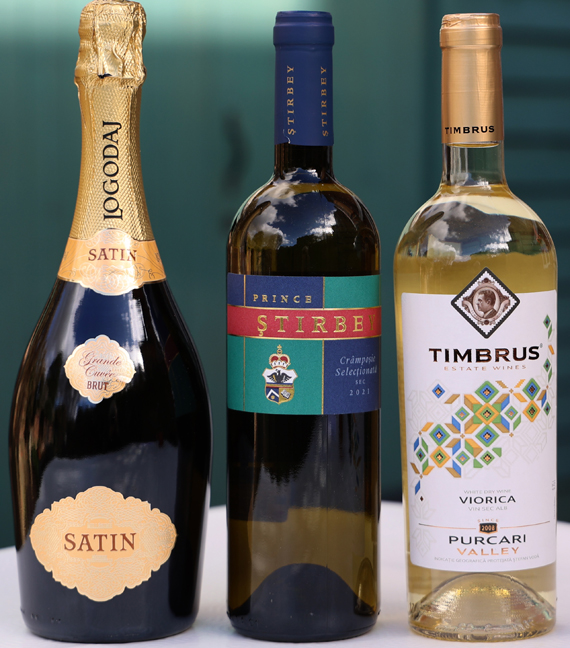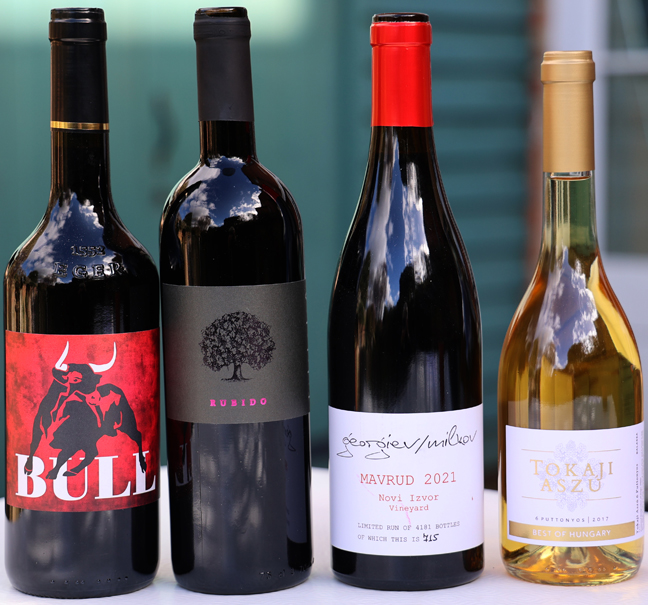 Background
Background
A botanist by training (she graduated from Keble College Oxford and gained a PhD at Bath) Caroline is a woman who knows her way around a vine in more detail than most!
Caroline’s wine journey began when, in 1988, she joined Augustus Barnett (the wine store chain, now of blessed memory) as a junior wine buyer. She tells us she suffered some envy when her colleagues were assigned to more glamorous areas such as Champagne, but her love of the wines of Eastern Europe was soon ignited.
Caroline’s first book, published in 2018, was The Wines of Bulgaria, Romania and Moldova and she contributes to all the main wine publications: Hugh Johnson’s Pocket Wine Guide, the World Atlas of Wine, the Oxford Companion to Wine and Sotheby’s Wine Encyclopaedia, to name but a few. She is also a panel chair for the Decanter World Wine Awards, is a frequent contributor to Decanter and was the first foreigner to be made a ‘Friend of Hungarian Winemakers’ and is a member of the Confrerie of Tokaj. She is a wine consultant to the supermarket chain Lidl.
Caroline set up her own business in 1995.
Introduction
Caroline started her presentation by reminding us of the geography of the region, how varied the history and culture is of each of the countries and how varied the topography. With national boundaries changing over time, often several times within a relatively few years, culture and ethnicity tend to be of greater importance than a ‘nationality badge’. Each of the countries represented in the tasting (Bulgaria, Romania, Moldova, Hungary and Slovenia) was introduced showing a map of the country, highlighting the main wine growing areas, and the main wine industry statistics and grapes were given. The latter information is shown in each of the sections below.
THE TASTING
Bulgaria
Under communism, Bulgaria was a planned economy, so had a well organised, large scale wine producing sector. Today the wine industry is small and niche, with lots of smaller wineries, not large person teams. In total, it is today about a quarter of the size of Bordeaux in terms of size.
Bulgaria Statistics 2020 - data from EAVW
Total vineyard area 60,162 ha
Vineyard area harvested for wine 29,108 ha
Red wine grapes 15,791 ha
White wine grapes 13,317 ha
99 wine grape varieties grown/harvested
Harvest (2020) 118,054 tonnes processed by wineries
Commercial wine production
2020: 735,359 hectolitres
2019: 857,375 hl (inc. 5,400hl PDO, 353,685 hl PGI)
282 registered wineries
Grapes in Production for Wine by Area (2021)
|
Leading Red Grapes
|
Hectares
|
|
Merlot
|
5,071
|
|
Cabernet Sauvignon
|
4,773
|
|
Pamid
|
1,058
|
|
Syrah
|
1,032
|
|
Mavrud
|
855
|
|
Cabernet Franc
|
668
|
|
Pinot Noir
|
516
|
|
Gamza
|
218
|
|
Broadleaf Melnik
|
197
|
|
Rubin
|
185
|
|
Storgozia
|
150
|
|
Malbec
|
141
|
|
Leading White Grapes
|
Hectares
|
|
Muscat Ottonel
|
3,103
|
|
Chardonnay
|
2,553
|
|
Sauvignon Blanc
|
1,307
|
|
Red Misket
|
1,170
|
|
Rkatsiteli
|
950
|
|
Dimiat
|
791
|
|
Traminer
|
725
|
|
Ugni Blanc
|
429
|
|
Tamianka
|
301
|
|
Rhine Riesling
|
255
|
|
Viognier
|
233
|
|
Pinot Gris
|
207
|
Wine 1 – Logodaj Satin Brut 2017
Situated in the Melnik area on the Struma River in South Western Bulgaria, in the sunniest and warmest part of the country, the Logodaj winery was established in 1994 and the wines are produced under the consultancy of enologist Riccardo Cotarella. The Broad Leaved Melnik Vine and Early Melnik Vine are grapes varieties grown only in this part of the world. Made from Broad Leaved Melnik, by the traditional method, the wine has considerable natural acidity. Manual sorting ensures good grape quality. It spends a minimum of two years on the lees. Straw yellow with golden hues, notes of citrus and yeasty brioche on the palate. Clean, medium bodied and complex on the finish. Sparkling wine production was introduced in the 1960s and a pink sparkling wine is also made by this winery.
Romania
Romania is the largest of the countries in this area by population size and is the fifth largest grower of grapes in Europe. Unusually, of the 85 varieties to be found, the two largest grape varieties grown are native, not ‘noble’. Most of the production is drunk within the country and relatively little is exported. For example, Romanians think Pinot Noir is ‘too thin’ and most wine drunk is made from native varieties. Exports of wine to Germany, the UK and the Netherlands are however growing. Most of the Romanian wine to be found in the UK comes from two large scale producers. The geography and the climate of the country is diverse with Romania only having achieved its current boundaries in 1918, which contributes to the diversity of its culture. Romania was not a designated wine export country under communism.
Romania Statistics 2021
- Total vineyard area: 180,345 ha
- Vineyard area Vitis vinifera: 97,042 ha
- Red wine: 2.3 m hl
- White wine: 2.2 m hl
- DOC/IG wines: 2.6 m hl (58%)
- Commercial wine production: 4.45 million hl (Exports 174,000 hl, imports 562,000 hl)
- Per capita consumption: 24.9 litres
Romania – Leading Grape Varieties 2021
|
Name
|
Area in Hectares
|
|
Fetească Regală
|
12289
|
|
Fetească Albă
|
12075
|
|
Merlot
|
11152
|
|
Other noble grapes
|
8488
|
|
Riesling Italico
|
7064
|
|
Sauvignon
|
5697
|
|
Aligoté
|
5204
|
|
Cabernet Sauvignon
|
5423
|
|
Muscat Ottonel
|
5156
|
|
Fetească Neagră
|
3187
|
|
Roșioară
|
2653
|
|
Băbească Neagră
|
2569
|
|
Pinot Noir
|
2040
|
|
Chardonnay
|
2009
|
|
Tămâioasă Românească (Muscat)
|
1747
|
|
Pinot Gris
|
1471
|
|
Burgund Mare (aka Blaufrankisch)
|
690
|
|
Busuioacă de Bohotin
|
678
|
Wine 2 – Prince Stirbey Cramposie Selectionata
The Cramposie grape variety goes back to pre-Roman Empire days when the region between the Danube and the Carpathians was inhabited by the Dacians. Since then, over the course of a few centuries, Cramposie vines have evolved to adapt to both soil and climate of the Drăgășani region in the south of the country. The grape is thought to be a cross between two other native varieties. This wine has become the white icon of the Drăgășani region as well as of the Prince Stirbey wine estate. The estate has an interesting history, with the family having managed to reclaim some of their estates which were seized during communism.
With refreshingly fruity notes (melon, grapefruit, lemon, lime) on the nose and the palate, the wine has bracing acidity and subtle minerality. The head wine maker is German. Could accompany fish dishes and asparagus.
Moldova
Moldova is a country whose population is in decline. However Moldovans refer to their country as being ’built on vine roots’ and think of the country as being shaped like a bunch of grapes. Although noble grape varieties are grown, Moldova is trying to make native varieties a unique selling proposition. However, many ‘local’ varieties are also to be found in Romania. There are three main wine producing areas. Under communism, Moldova was a major producer of semi-sweet wines for Russia but Russia subsequently banned imports of Moldovan wines which had a disastrous effect on the country’s economy. (Most heavy industry is located in the northern breakaway area of Transnistria.)
Moldova Key Facts
|
Area under noble wine grapes
|
70,200ha
|
|
Area in vineyard register to date
|
34,000 ha
(1,403ha local grapes)
|
|
Total area under vine (incl hybrids & table grapes)
|
124,000 ha
|
|
Harvest volume
|
263,000 tonnes
|
|
Wine production
|
1.46 million hl (57% still wine is white)
|
|
Leading export markets
|
Romania, China, Poland, Russia, Czech Republic
|
|
Wine exports
|
83% by volume, 3% of GDP, 7% export value
|
Moldova Leading Varieties (2019) from registered vineyards by hectare
Cabernet Sauvignon 4644
Merlot 4523
Aligoté 4523
Sauvignon 4154
Rkatsiteli 2538
Other noble grapes 7138
Chardonnay 2319
Pinot Noir 1271
Riesling 954
Cabernet Franc 495
Saperavi 352
Moldova’s Local Grape Varieties
- Reds
- Rara Neagra (aka Babeasca Neagra)
- Feteasca Neagra
- Codrinschii (Rara Neagra/Cabernet Sauvignon cross from 1970)
- Whites
- Viorica (Siebel 1366 x Aleatico 1969)
- Feteasca Alba
- Feteasca Regala
- Alb de Onitcani (Chil Gyulyabi x (pollen mix of Pierrelle + Seyanets 244 1970)
- Riton (Villard Blanc x Gewurztraminer, no date)
NB 1,403ha local grapes in register by 2018
Wine 3 – Timbrus Viorica 2021
Viorica is an indigenous Moldovan grape variety, which is distinguished by its special aroma and taste. Largely disease and frost resistant, Viorica is the potential flagship of Moldovan white wines and the grape is thought to be a ‘grandchild’ of Muscat. Straw yellow in colour. Complex aromas and flavours on the nose and palate, including basil, flower, fruits and citrus notes. Aromatic. Balancing acidity and long. Produced in the Purcari region and part owned by a Spaniard, Manuel Ortiz. The winery was founded in 2016. Protected Geographical Indication Stefan-Voda.
Hungary
Hungary was a designated wine export area under communism. However, in Hungary people were allowed to keep a small amount of land, relative to the number of people in each family, and so to some extent wine production knowledge was retained. Nevertheless, following the fall of communism, vast areas of vines were grubbed up. More wine was produced by Hungary than New Zealand in 2017. Tokaj is the possibly best-known of Hungarian wines, alongside Bulls Blood.
Selected key facts – Hungary
- Area in production (2021) 57,600 ha
- White grapes (2021) 39,852 ha
- Red grapes (2021) 17,748 ha
- 571,000ha in 18th century (third biggest vineyard area in world)
- 22 wine regions, 33 PDOs registered with EU, 5 PGIs
- Total wine production 2.9 million hl (2020)
- 178 varieties grown in 2021
- Top export market for bottled wine is now UK
 Wine 4 – St Andrea Bull Bikavér
Wine 4 – St Andrea Bull Bikavér
Produced in the Eger region, where the soil is mainly volcanic and the climate cool. Eger is a protected area. The family-owned St Andrea vineyard team is trying to rehabilitate the reputation of ‘Bulls Blood’ type wines. Made from a blend of grapes with Kékfrankos (aka Blaufrankisch) as the majority. The winery is located on a south-facing hillside. Some oak ageing (c1 year) using native Hungarian oak. Deep and complex nose with aromas of red cherry, red berries and a hint of liquorice root. Savoury cool-climate style with notes of ripe bramble and leafy black fruits complemented by oak, chocolate and sweet smoked spice. Soft, ripe tannins and fine acidity. A good food wine with ageing potential.
____________________________________________________________________
Slovenia
A small country with around 2 million inhabitants, Slovenia has three main wine regions – Podravje in the north east, Posavje to the south of it and Primorska in the west.
Wine 5 – Tilia Estate Rubido 2018
Produced in Vipava Valley, in the Primorska area close to Italy, this red wine is made from low yielding vines. 70% Merlot and 30% Cabernet Sauvignon, so Bordeaux in style. The area is Alpine with some Mediterranean influence so the merlot does not over ripen. The producer is a specialist in pinot noir production but these are very highly priced. Grapes are hand-picked. The soil is marl and clay. Aged for 16 months in Slavonian and French oak barrique barrels (10% new). Ruby color with youthful violet hues. Mature cabernet sauvignon blackcurrant nose plus aromas of ripe red fruits (bramble, raspberry, cherry), some spicy cinnamon notes, vanilla and some smoky notes. Soft tannins and good acidity. Ready to drink now but will keep for 5 – 10 years.
Back to Moldova
Wine 6 – Novak Feteasca Neagra/Saperavi 2019
Made in the south-west corner of the country, the hottest area, which is home to the biggest and boldest reds that are produced in Moldova. Saperavi was a Georgian grape but is well-suited to Moldovan conditions. Feteasca Neagra is an old indigenous Moldovan variety. Andrey Novak has set up a micro winery within the large family estate. Aged in oak. Garnet red, rich and predominant oak on the nose with ripe red and black fruits. Some pepper and spice on the palate. Prominent alcohol although 13.5%. Ready to drink now.
Back to Bulgaria
Wine 7 – Georgiev/Milkov Mavrud Novi Izvor Vineyard
These two winemakers are working on personal projects with parcels of old vines all over the country. Mavrud is the flagship native grape of Bulgaria and an ancient legend of ‘Khan Krum’ credits the grape with granting great strength. The vines are around 40 years old and the Mavrud vineyard is situated near the village of Novi Izvor. The winemakers use modern wine-making techniques, having worked around the world including in the USA, New Zealand, China, Austria and Malta. Deep ruby colour with crimson hues. On the nose and palate, very pronounced red and black fruit notes, combined with sweet vanilla and roasted nuts. Medium to full bodied with great balance, well integrated ripe tannins and intense notes of blueberries, redcurrants, dried herbs and spices.
Back to Hungary
Wine 8 – Balassa for Best of Hungary Aszú 6 Puttonyos 2017
From the cool north of Hungary and an area where two rivers meet and the soil is volcanic. The mountain breezes and fogs on autumn mornings are ideal for the formation of botrytis. Picking is by hand. There are no rules as to which grape is used either for the soaking must or for the grapes used for the final wine, with the six varieties shown below permitted for either. However Furmint is an estimated 70% of all plantings. Aszú has a reputation for living for decades. From the family-owned Balassa winery in the town of Tokaj. The wine maker is Istvan Balassa. Deep gold colour and a complex, intense nose packed with honey, flowers and rich spiced fruit. A creamy mouthfeel is balanced by gentle acidity, while the rich palate of apricot jam, orange peel, honey and sweet spices culminates in a long dried fruit and floral finish.
Tokaj Facts and Figures
|
Vineyard Area in production
|
5189ha
|
|
Furmint -total area
-in production
|
3424ha
3317ha
|
|
Six authorised varieties
|
Furmint,
Hárslevelű,
Sárgamuskotály,
Kövérszőlő,
Zéta,
Kabar
|
|
Volcanic bedrock
|
Rhyolite, Rhyolite Tuff, Dacite, Andesite, with outcrops of Zeolite, Perlite, Kaolin
|
|
Soil types
|
Nyirok (red clay from weathered volcanic rocks),
Loess (fine windblown silt with clay and sometimes sand),
Rock flour (weathered pumice, rhyolite, perlite)
|
HRE 27.2.23